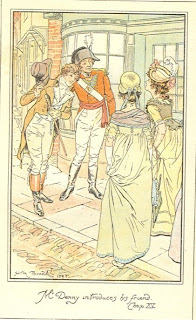Two Hundred Years of Pride and Prejudice
On January 27, 1813, a novel in three volumes was published in London by The Author of Sense and Sensibility.
The title Pride and Prejudice may have come from a paragraph in one of the novels of Fanny Burney, Cecilia (1782).
“…if to PRIDE and PREJUDICE you owe your miseries, so wonderfully is good and evil balanced, that to PRIDE and PREJUDICE you will also owe their termination.”
Austen admired Burney’s work, and J. Austen is listed as one of the subscribers to Burney’s novel Camilla, published in 1796
Austen admired Burney’s work, and J. Austen is listed as one of the subscribers to Burney’s novel Camilla, published in 1796
Austen received £110 for the novel’s copyright from Publisher Thomas Egerton, who subsequently made a handsome profit from several editions of Pride and Prejudice. The novel has been in the pubic domain for many decades and is estimated to have sold over 20 million copies worldwide, not to mention many adaptations for the stage and screen. In almost all listings of the best and/or most beloved novels, Pride and Prejudice tops all others — or comes very close.
Pride and Prejudice was first drafted as First Impressions in 1796 and 1797 when Jane Austen was about 21 years of age. She had spent her childhood in a lively family, often entertaining her parents, brothers, her sister Cassandra, with her sometimes silly and sometimes witty stories.
This year the 200th anniversary of Pride and Prejudice is being observed worldwide in all imaginable ways. In the next few months, we will discuss a few of them now and then.
One of the most-looked-forward-to books is The Cambridge Companion to Pride ad Prejudice, edited by Janet Todd.. This much-anticipated volume will be available in April.
For more information on this volume, click here.
l-r, Liz Philosophos Cooper, JASNA-WI outgoing regional coordinator;
UW Professor Emily Auerbach; and current regional coordinator Judy Beine
at the 2012 Jane Austen Birthday Celebration, December 15, in Milwaukee, WI
Last December, Professor Emily Auerbach of the University of Wisconsin presented a preview of her chapter of the Cambridge Companion at the JASNA-WI celebration of Jane Austen’s Birthday.
Dr. Auerbach, who is the author of Searching for Jane Austen and teaches Austen’s works to students of many ages and backgrounds, in the classroom and on radio, has written the Cambridge Companion Chapter on “Pride and Proliferation.” She admitted that any discussion of the many sequels, prequels, continuations, adaptations, and mash-ups would be immediately outdated by new offerings almost every week.
Some books combine characters from some or all of Austen’s novels. Zombies, vampires and werewolves have invaded some versions of Meryton. Others are set in new time periods, even into the future, and in new locations, from Boca Raton to Mumbai.
Particularly popular have been further stories of the Bennet girls, Anne de Bourgh and especially Georgiana Darcy who alone has been married innumerable times in fan fiction. The fates of unborn children of the Darcys, Bingleys, Collinses and many more characters are imagined.
All of this attention, Auerbach tells us, confirms Austen as a full-fledged BRAND, in the 21st century sense of the word. But even for the most devoted Janeite, this bewildering proliferation of tales also confirms our incurable addition to Jane Austen and her universal characters who transcend all categories to prove the power of her sparkling novel.
Read on!





